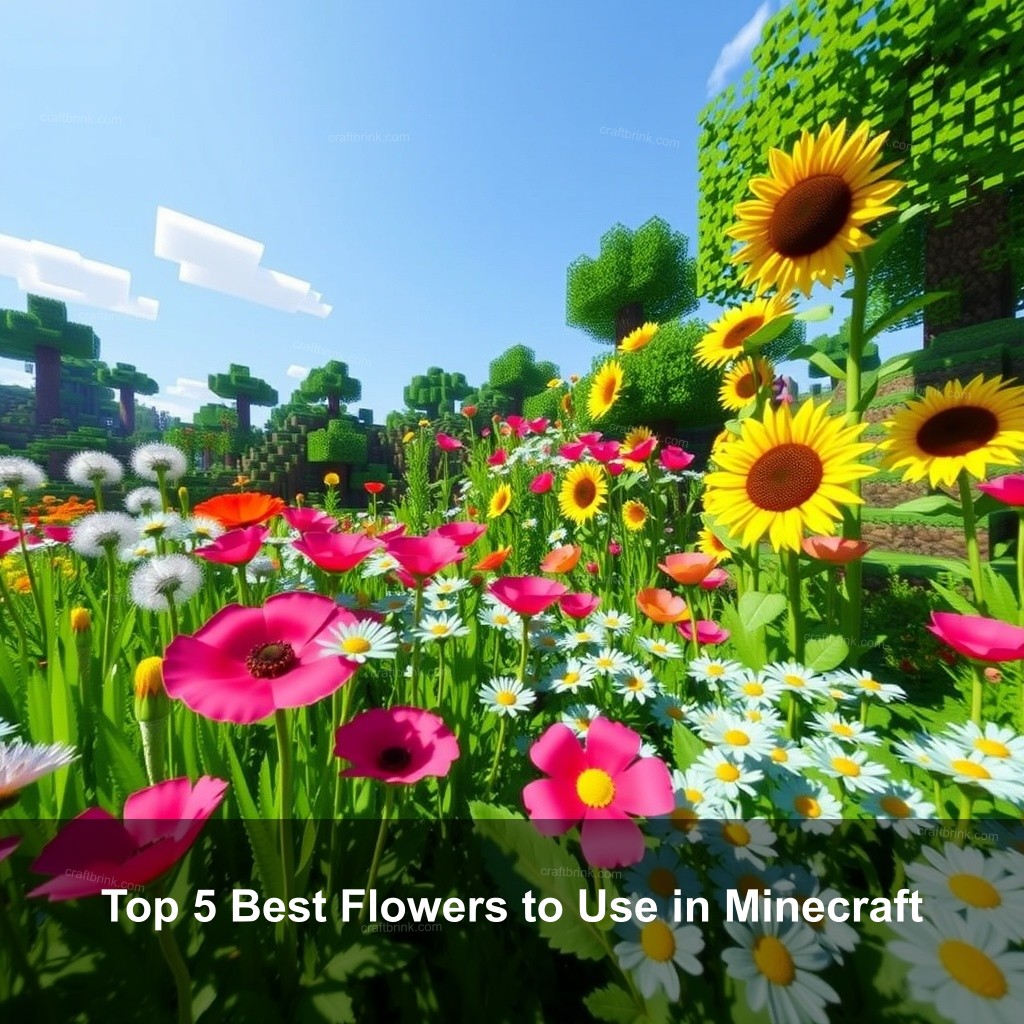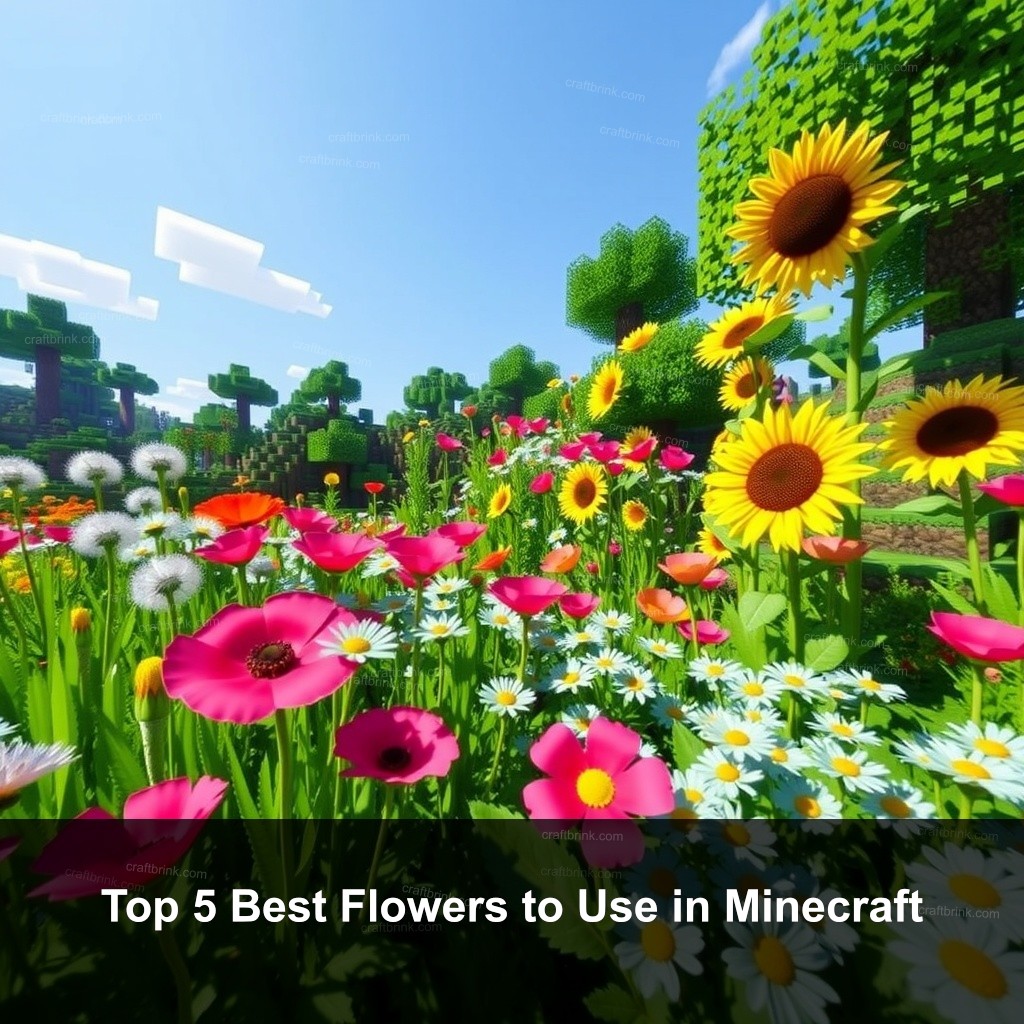Are you ready to add some color and beauty to your Minecraft world? Flowers can transform your builds and enhance your gameplay. In this article from CraftBrink, we’ll explore the top 5 best flowers to use in Minecraft. You’ll learn about their uses, how to find them, and tips for creating stunning flower gardens. Let’s dig in and discover the floral wonders of Minecraft!

Top 5 Best Flowers to Use in Minecraft
Minecraft offers a variety of flowers, each with unique characteristics and uses. Knowing which flowers to choose can improve your building appeal and functional gameplay. Here are the top five flowers that every player should consider integrating into their Minecraft creations.
Understanding Minecraft Flowers
Before we jump into the best flowers, it’s essential to grasp their types and roles in the game. Flowers in Minecraft not only beautify your environment but also serve practical purposes. They can be used for crafting dyes, breeding certain animals, and even as decorative elements in your builds. The diversity of flowers is vast, spanning across different biomes.
In this section, we will categorize various flowers and discuss their significance in Minecraft gameplay.
| Flower Type | Color | Biome |
|---|---|---|
| Dandelion | Yellow | Various |
| Poppy | Red | Plains |
| Sunflower | Yellow | Sunflower Plains |
| Blue Orchid | Light Blue | Swamp |
| Lily of the Valley | White | Forest |
These flowers are not just beautiful; they play important roles in crafting and aesthetics. For more details on the various types, check out our article on types of minecraft flowers.
The Best Flowers for Building in Minecraft
Building in Minecraft becomes an artistic endeavor when you incorporate flowers. The right selection can improve your structures’ aesthetics and add functionality. Here are some flowers that are particularly effective for building:
- Peony: This two-block tall flower adds elegance and can be planted in flower pots.
- Lilac: Another two-block flower that adds height and depth to your gardens.
- Cornflower: Known for its deep blue color, it boosts the visual appeal.
- Rose Bush: Offers two flowers on one bush, great for dense floral arrangements.
When selecting flowers for your builds, consider their height, color, and the overall aesthetic you wish to achieve. For further insights on how to create beautiful flower arrangements and gardens, visit our guide on flower garden ideas.
Most Popular Flowers in Minecraft
Popularity often stems from utility and beauty. Here are the most beloved flowers in the Minecraft community:
- Poppy: Its vibrant red hue makes it a favorite for players.
- Dandelion: Accessible and easy to use in various crafting recipes.
- Sunflower: Unique for its height and orientation, making it a trendy choice.
These flowers not only improve your builds but also serve practical purposes like crafting dyes. For a comprehensive look at where to find these flowers, check out our resource on where to find flowers.
How to Create a Flower Garden in Minecraft
Creating a flower garden can be a rewarding aspect of gameplay. Here’s how to craft a beautiful garden:
- Choose Your Location: Find a flat area with ample sunlight. Access to water can also help.
- Select Your Flowers: Mix tall and short flowers for visual interest. Consider using Poppies and Cornflowers for contrast.
- Plant and Arrange: Use a random pattern for a natural look. Plant flowers in clusters for a fuller appearance.
Maintenance is crucial for your garden. Regularly use bone meal to promote growth and ensure your flowers flourish! For tips on how to grow flowers effectively, see our article on how to grow flowers in minecraft.

Unique Flowers and Their Features in Minecraft
Some flowers are rare but highly sought after for their unique features. Here are a few:
- Wither Rose: This flower can only be obtained by killing a Wither or a mob in the presence of a Wither.
- Azure Bluet: A small flower that adds a splash of light gray to your garden.
These unique flowers often have special attributes, such as the Wither Rose’s ability to inflict the Wither effect on entities that come into contact with it. For crafting ideas involving these unique flowers, refer to our guide on crafting with flowers.
Flower Crafting Recipes and Uses
Flowers are not just for decoration; they play a significant role in crafting.
- Dyes: Flowers can be transformed into dyes. For instance, Dandelions yield yellow dye, while Poppies produce red dye.
- Suspicious Stew: This unique food item can grant beneficial effects based on the flower used to craft it.
Understanding how to utilize flowers in crafting can improve your gameplay experience and provide you with valuable resources. For a detailed look at crafting recipes, check out our resource on crafting with flowers.
FAQs
What are the best flowers for decoration in Minecraft?
The best flowers for decoration include Peonies, Lilacs, and Sunflowers. They add height and color, improving the overall aesthetic of your builds.
How do I grow flowers in Minecraft?
To grow flowers, plant them on grass or dirt blocks. You can also use bone meal to encourage growth in the surrounding area. For a step-by-step guide, refer to our article on how to grow flowers in minecraft.
Can I craft with flowers in Minecraft?
Absolutely! Flowers can be used to craft various dyes and items like Suspicious Stew, which provides different effects based on the flower used.
Conclusion
In summary, flowers play an important role in Minecraft, improving both aesthetics and gameplay. Whether you’re building a garden or looking to craft valuable items, knowing the best flowers to use can elevate your experience. Join the community of Minecraft builders and flower enthusiasts by sharing your favorite flowers or garden creations in the comments below. Explore more on CraftBrink for additional tips and tricks!
